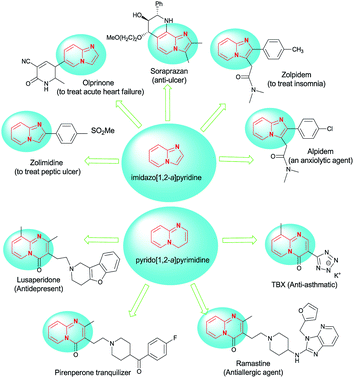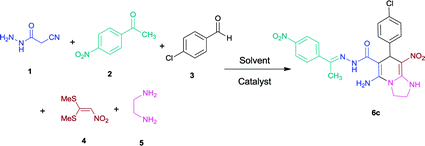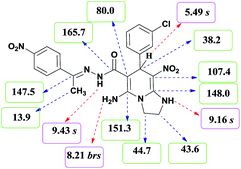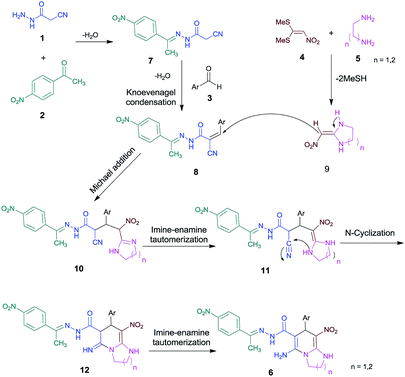 Open Access Article
Open Access ArticleCreative Commons Attribution 3.0 Unported Licence
An efficient synthesis of new imidazo[1,2-a]pyridine-6-carbohydrazide and pyrido[1,2-a]pyrimidine-7-carbohydrazide derivatives via a five-component cascade reaction†
Hajar Hosseini and
Mohammad Bayat
and
Mohammad Bayat *
*
Department of Chemistry, Faculty of Science, Imam Khomeini International University, Qazvin, Iran. E-mail: bayat_mo@yahoo.com; m.bayat@sci.ikiu.ac.ir; Tel: +98 28 33780040
First published on 5th March 2019
Abstract
A highly efficient and straightforward synthesis of N-fused heterocyclic compounds including N′-(1-(4-nitrophenyl)ethylidene)imidazo[1,2-a]pyridine-6-carbohydrazide and N′-(1-(4-nitrophenyl)ethylidene)pyrido[1,2-a]pyrimidine-7-carbohydrazide derivatives is successfully achieved via a five-component cascade reaction utilizing cyanoacetohydrazide, 4-nitroacetophenone, 1,1-bis(methylthio)-2-nitroethylene and various diamines in a mixture of water and ethanol. The new efficient domino protocol involving a sequence of N,N-acetal formation, Knoevenagel condensation, Michael reaction, imine–enamine tautomerization and N-cyclization as key steps. The merit of this catalyst free approach is highlighted by its easily available starting materials, operational simplicity, clean reaction profile, the use of environmentally benign solvents and tolerance of a wide variety of functional groups.
Introduction
Imidazopyridines have displayed a broad spectrum of pharmacological and biological activities.1 Among the diverse derivatives of imidazopyridine, the imidazo[1,2-a]pyridine skeleton is probably the most important structure due to its vital role as a key construction in drugs and biologically active compounds with properties such as anti-inflammatory,2,3 antiviral,4–6 antifungal,7–9 anticancer,10 anxiolytic,11 anti-ulcer,12 and antiprotozoal.13 They can be found in marketed drugs such as the clinical anti-ulcer compound zolpidem and alpidem,14 olprinone,15 zolimidine,16 necopidem and saripidem17 (Fig. 1).Pyridopyrimidine derivatives are also known as antidepressant,18 gastrointestinal protective,19 neurotropic and stress-protecting,20 and anticancer agents.21 pyrido[1,2-a]pyrimidine constitutes the core structure of some marketed drugs, including the antiasthmatic agent pemirolast,22 the tranquilizer pirenperone,23 and the antiallergic agent ramastine24 (Fig. 1).
The design of reactions with minimized number of steps is one of the purpose of modern synthesis. One approach to achieve this goal includes the development of multicomponent methods. Multicomponent reactions (MCRs) offer a wide range of probabilities for the fast generation of functionalized molecules in a single step with high atom economy, minimum time and cost and straight forward experimental procedures.25 These benefits are highlights for multicomponent cascade reactions, which involve in situ production of an intermediate with a reactive site for subsequent transformations.26
By now, various synthetic approaches have been reported to synthesize imidazo[1,2-a]pyridines. The common reactions were the cyclocondensations of 2-aminopyridines with α-halocarbonyl compounds,27 1,3-dicarbonyl compounds,28 nitroolefins or alkynes.29 Condensation of 2-aminopyridines, aldehydes and isonitriles or alkynes in a one-pot process, was also a convenient method for the synthesis of imidazo[1,2-a]pyridines.30 Furthermore, over the past decade, a number of methods have been described to synthesize pyrido[1,2-a]pyrimidines by focusing on traditional two-component condensation of 2-aminopyridines with a variety of bifunctional electrophiles.31–33
In recent years some other new synthetic approaches have been developed for the synthesis of tetrahydroimidazo[1,2-a]pyridines and tetrahydro-1H-pyrido[1,2-a]pyrimidine using heterocyclic ketene aminals (HKAs).34–38 Heterocyclic ketene aminals (HKAs) are efficient synthons for the synthesis of heterocyclic compounds. Reactions of cyclic ketene aminals with a variety of bis-electrophilic compounds have so far been applied to construct five- and six-membered fused heterocyclic structures.39
In the process of our efforts to synthesize the new heterocyclic compounds using cyanoacetohydrazide, we report herein an efficient one-pot five-component synthesis of novel imidazo[1,2-a]pyridine-6-carbohydrazides and 1H-pyrido[1,2-a]pyrimidine-7-carbohydrazides via in situ preparation of nitroketene aminals. To the best of our knowledge, there is no report on the synthesis of these structures.
Results and discussion
We succeeded in synthesizing two categories of functionalized N-fused heterocyclic structures containing tetrahydroimidazo[1,2-a]pyridines-6-carbohydrazides and tetrahydro-1H-pyrido[1,2-a]pyrimidine-7-carbohydrazides by using of cyanoacetohydrazide 1, 4-nitroacetophenone 2, aromatic aldehydes 3, 1,1-bis(methylthio)-2-nitroethene 4 and various diamines 5.Optimization of the conditions
Initially, cyanoacetohydrazide 1, 4-nitroacetophenone 2, 4-chlorobenzaldehyde 3, 1,1-bis(methylthio)-2-nitroethene 4 and ethylenediamine 5 were used as model substrates to optimize the reaction conditions.The experimental results showed when ethanol was used as solvent without any catalyst at reflux conditions, the yield of desired product was 60% (Table 1, entry 1). With piperidine as catalyst, the reaction efficiency did not change significantly (entry 2). With p-TSA and acetic acid, the product did not form (entry 3, 4). The use of water or acetonitrile instead of ethanol did not result in the desired product (entry 5, 8), but when the mixture of water and ethanol was used (overall 1![[thin space (1/6-em)]](https://www.rsc.org/images/entities/char_2009.gif) :
:![[thin space (1/6-em)]](https://www.rsc.org/images/entities/char_2009.gif) 2, v/v), the efficiency increased slightly (entry 6). By changing the ratio of solvents (1
2, v/v), the efficiency increased slightly (entry 6). By changing the ratio of solvents (1![[thin space (1/6-em)]](https://www.rsc.org/images/entities/char_2009.gif) :
:![[thin space (1/6-em)]](https://www.rsc.org/images/entities/char_2009.gif) 3, v/v) at reflux conditions the five-component product 6c was obtained in a yield of 87% within 5 hours (entry 7).
3, v/v) at reflux conditions the five-component product 6c was obtained in a yield of 87% within 5 hours (entry 7).
| Entry | Solvent | Catalyst (mol%) | Time (h) | Temp (°C) | Yield (%) |
|---|---|---|---|---|---|
| a Reagents and conditions: cyanoacetohydrazide (1 mmol), 4-nitroacetophenone (1 mmol), 4-chlorobenzaldehyde (1 mmol), 1,1-bis(methylthio)-2-nitroethene (1 mmol), ethylenediamine (1 mmol), solvent (20 mL), catalyst (0.2 mmol). The bold row represents the best results. | |||||
| 1 | EtOH | — | 24 | 78 | 60 |
| 2 | EtOH | Piperidine | 24 | 78 | 57 |
| 3 | EtOH | p-TSA | 24 | 78 | No reaction |
| 4 | EtOH | AcOH | 24 | 78 | No reaction |
| 5 | H2O | — | 24 | 100 | No reaction |
| 6 | H2O/EtOH (1![[thin space (1/6-em)]](https://www.rsc.org/images/entities/char_2009.gif) : :![[thin space (1/6-em)]](https://www.rsc.org/images/entities/char_2009.gif) 2, v/v) 2, v/v) |
— | 10 | 78 | 65 |
| 7 | H2O/EtOH (1![[thin space (1/6-em)]](https://www.rsc.org/images/entities/char_2009.gif) : :![[thin space (1/6-em)]](https://www.rsc.org/images/entities/char_2009.gif) 3, v/v) 3, v/v) |
— | 5 | 78 | 87 |
| 8 | CH3CN | — | 24 | 82 | No reaction |
With information obtained from optimization conditions table, we used cyanoacetohydrazide 1, 4-nitroacetophenone 2, various aromatic aldehydes 3, 1,1-bis(methylthio)-2-nitroethene 4 and diamines (ethylenediamine, 1,3-diaminopropane, 2,2-dimethyl-1,3-diaminopropane) 5 as starting materials to synthesize the target compounds 6a–q (Scheme 1).
The reactions were completed after 4–7 h overall to afford corresponding heterocyclic systems in good to high yields (73–90%). The results are summarized in Table 2.
| Entry | Aromatic aldehyde | Diamine | Product | Time (h) | Yield (%) | Mp (°C) |
|---|---|---|---|---|---|---|
| a The reaction was performed using cyanoacetohydrazide (1 mmol), 4-nitroacetophenone (1 mmol), aromatic aldehyde (1 mmol), 1,1-bis(methylthio)-2-nitroethene (1 mmol), diamine (1 mmol), EtOH (15 mL), H2O (5 mL), reflux. | ||||||
| 1 |  |
 |
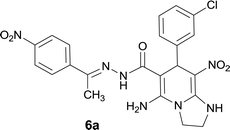 |
6 | 90 | 231–233 |
| 2 |  |
 |
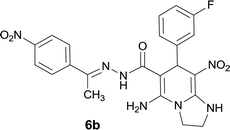 |
5 | 86 | 235–237 |
| 3 |  |
 |
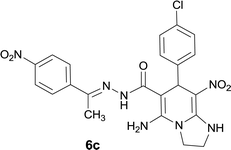 |
5 | 87 | 239–241 |
| 4 |  |
 |
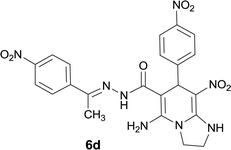 |
4 | 89 | 243–245 |
| 5 |  |
 |
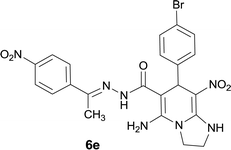 |
5 | 90 | 239–240 |
| 6 |  |
 |
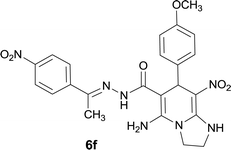 |
7 | 78 | 267–269 |
| 7 |  |
 |
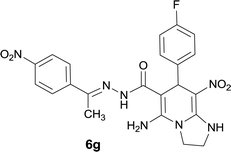 |
5 | 80 | 271–273 |
| 8 |  |
 |
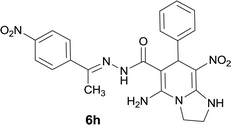 |
6 | 75 | 284–286 |
| 9 |  |
 |
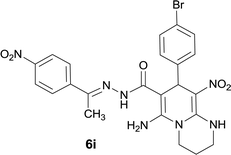 |
5 | 86 | 264–266 |
| 10 |  |
 |
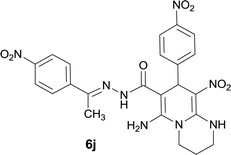 |
4 | 88 | 268–270 |
| 11 |  |
 |
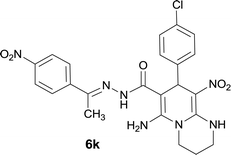 |
5 | 85 | 265–267 |
| 12 |  |
 |
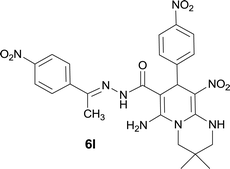 |
4 | 90 | 298–300 |
| 13 |  |
 |
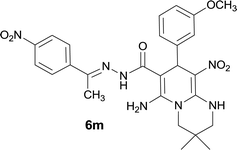 |
7 | 73 | 269–271 |
| 14 |  |
 |
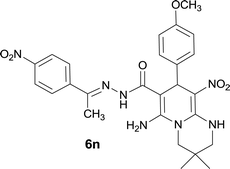 |
7 | 75 | 315–317 |
| 15 |  |
 |
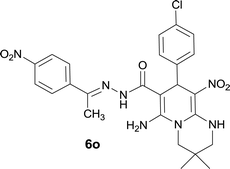 |
5 | 85 | 317–319 |
| 16 |  |
 |
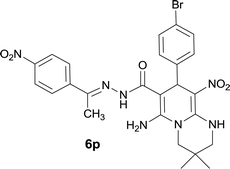 |
5 | 84 | 322–324 |
| 17 |  |
 |
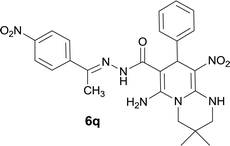 |
6 | 75 | 329–331 |
Effect of substituents
From the observation of reaction times in Table 2, it was found that with aldehydes containing an electron-withdrawing group on para position of ring (nitro and halogens), the reaction rate is the highest and with methoxy group, the rate is the lowest.This reaction was performed with other derivatives of diamines (1,4-diaminobutane and 1,2-diaminocyclohexane) under the same conditions, which did not result in the product. Also the reaction with ortho derivatives of benzaldehyde (2-chloro and 2-nitro) did not produce the desired product. Other derivatives of acetophenone (4-chloro, 4-bromo and 4-methoxyacetophenone) were also used which resulted no product formation.
In addition, the reaction with aliphatic ketones instead of 4-nitroacetophenone and aliphatic aldehydes instead of aromatic aldehydes did not lead to the desired products.
It should be noted that these reactions involve two-, three- and four-component impurities. In fact, the most important side product was a four-component structure without participation of 4-nitroacetophenone that was previously synthesized using two equivalents of aldehyde.34 To achieve the pure product, it was necessary to complete the reaction of cyanoacetohydrazide and 4-nitroacetophenone in a mixture of water and ethanol at reflux conditions in sufficient time (3 hours), then ketene aminal solution and aromatic aldehyde were added at the same time.
Structure determination
The structures of compounds 6a–q were deduced from their IR, 1H NMR, 13C NMR spectroscopic and Mass spectrometric data (see the ESI†).The formation of suggested products 6a–q is clearly verified by the 1H and 13C NMR spectra of the crude products. As a representative case the key signals of 1H and 13C NMR chemical shifts of 5-amino-7-(3-chlorophenyl)-8-nitro-N′-(1-(4-nitrophenyl)ethylidene)-1,2,3,7-tetrahydroimidazo[1,2-a]pyridine-6-carbohydrazide 6a are presented in Fig. 2.
The 1H NMR spectrum of 6a showed two NH groups at δ 9.16 and 9.43 ppm. The protons of 4-nitrobenzene ring were seen at δ 7.96 and 8.20 ppm as two doublet signals and the protons of 3-chlorobenzene ring were observed at δ 6.92–7.31 ppm. The NH2 group appeared at δ 8.21 ppm. The proton of CH at pyridine ring was seen at δ 5.49 ppm. Two protons of two methylene groups appeared at δ 3.81 and 4.05 ppm. The signal at δ 2.14 ppm was related to methyl group.
The 1H-decoupled 13C NMR spectrum of 6a indicated 20 distinct resonances in accordance to desired structure. The characteristic signals of four aliphatic carbons (CH3, CH and two CH2 groups) were seen at δ 13.9, 38.2, 43.6 and 44.7 ppm respectively. Two signals at δ 80.0 and 107.4 ppm were related to C![[double bond, length as m-dash]](https://www.rsc.org/images/entities/char_e001.gif) C–CO and C–NO2 respectively. The carbonyl group appeared at δ 165.78 ppm (Fig. 2).
C–CO and C–NO2 respectively. The carbonyl group appeared at δ 165.78 ppm (Fig. 2).
The mass spectrum of 6a displayed the molecular-ion peak at m/z 497 in agreement with the proposed structure. The IR spectrum of this compound showed absorption bands at 3486, 3400, 3327 cm−1 due to NH and NH2 groups, stretching vibration of aliphatic C–H bands at 2909, and strong absorption of carbonyl group at 1658 and C–N band at 1254 cm−1. Two absorption bands due to nitro group appeared at 1519 and 1375 cm−1.
Mechanism
A general reasonable mechanism for the formation of imidazo[1,2-a]pyridines-6-carbohydrazides and pyrido[1,2-a]pyrimidine-7-carbohydrazides is shown in Scheme 2. On the basis of well-established chemistry of 1,1-bis(methylthio)-2-nitroethene, initially, addition of diamine 5 to 1,1-bis(methylthio)-2-nitroethene 4 leads to the formation of ketene aminal 9. On the other hand condensation of cyanoacetohydrazide 1 with 4-nitroacetophenone 2 leads to hydrazone 7. Further, with adding aldehyde 3, the Knoevenagel condensation affords intermediate 8. Then, Michael addition of ketene aminal 9 to adduct 8 leads to the intermediate 10, which undergoes successive imine–enamine tautomerization followed by an intramolecular cyclization via nucleophilic addition of –NH to nitrile group. Finally, imine–enamine tautomerization gives the titled products 6 (Scheme 2).Experimental
Materials
All commercially available reagents and other solvents were purchased from Aldrich and Merck chemical Co. and used without further purification. The NMR spectra were recorded with a Bruker DRX-300 AVANCE instrument (300 MHz for 1H and 75.4 MHz for 13C) with DMSO-d6 as solvent. Chemical shifts are given in ppm (δ), and coupling constant (J) are reported in Hertz (Hz). Melting points were measured with an electrothermal 9100 apparatus. Mass spectra were recorded with an Agilent 5975C VL MSD with Triple-Axis detector operating at an ionization potential of 70 eV. IR spectra were measured with Bruker Tensor 27 spectrometer. Elemental analyses for C, H and N were performed using a PerkinElmer 2004 series [II] CHN elemental analyzer.General procedure of the synthesis of tetrahydroimidazo[1,2-a]pyridine-6-carbohydrazide and tetrahydro-1H-pyrido[1,2-a]pyrimidine-7-carbohydrazide derivatives
A mixture of diamine (1 mmol), 1,1-bis(methylthio)-2-nitroethylene (0.165 g, 1 mmol) and 10 mL EtOH in a 50 mL flask was refluxed for 6 hours. In another 50 mL flask the stoichiometric mixture of cyanoacetohydrazide (1 mmol, 0.099 g) and 4-nitroacetophenone (1 mmol, 0.165 g) in H2O/EtOH (5![[thin space (1/6-em)]](https://www.rsc.org/images/entities/char_2009.gif) :
:![[thin space (1/6-em)]](https://www.rsc.org/images/entities/char_2009.gif) 5 mL) was stirred at reflux conditions for 3 hours. After this time, TLC shows the consumption of the starting components. Then, aromatic aldehyde (1 mmol) and the first solution (HKA), was added to this mixture simultaneously. The progress of the reaction was monitored by TLC using ethyl acetate/n-hexane (1
5 mL) was stirred at reflux conditions for 3 hours. After this time, TLC shows the consumption of the starting components. Then, aromatic aldehyde (1 mmol) and the first solution (HKA), was added to this mixture simultaneously. The progress of the reaction was monitored by TLC using ethyl acetate/n-hexane (1![[thin space (1/6-em)]](https://www.rsc.org/images/entities/char_2009.gif) :
:![[thin space (1/6-em)]](https://www.rsc.org/images/entities/char_2009.gif) 1). After completion of the reaction, the precipitated product was collected by filtration and washed with warm ethanol to give the pure products 6a–q in 73–90% yield.
1). After completion of the reaction, the precipitated product was collected by filtration and washed with warm ethanol to give the pure products 6a–q in 73–90% yield.
![[double bond, length as m-dash]](https://www.rsc.org/images/entities/char_e001.gif) C–CO), 107.4 (C
C–CO), 107.4 (C![[double bond, length as m-dash]](https://www.rsc.org/images/entities/char_e001.gif) C–NO2), 123.9, 126.8, 127.1, 127.3, 128.3, 130.3, 132.8, 145.0, 147.3 (Ar), 147.5 (Me–C
C–NO2), 123.9, 126.8, 127.1, 127.3, 128.3, 130.3, 132.8, 145.0, 147.3 (Ar), 147.5 (Me–C![[double bond, length as m-dash]](https://www.rsc.org/images/entities/char_e001.gif) N), 148.0 (C
N), 148.0 (C![[double bond, length as m-dash]](https://www.rsc.org/images/entities/char_e001.gif) C–NH), 151.3 (CAr–NO2), 151.4 (C
C–NH), 151.3 (CAr–NO2), 151.4 (C![[double bond, length as m-dash]](https://www.rsc.org/images/entities/char_e001.gif) C–NH2), 165.7 (C
C–NH2), 165.7 (C![[double bond, length as m-dash]](https://www.rsc.org/images/entities/char_e001.gif) O); MS (EI, 70 eV): m/z (%) = 497 (0.008) [M]+, 454 (2), 326 (59), 311 (100), 292 (29), 265 (37), 246 (51), 204 (26), 179 (63), 117 (83), 76 (47), 57 (7); anal. calcd for C22H20ClN7O5: C, 53.07; H, 4.05; N, 19.69. Found: C, 53.37; H, 3.84; N, 19.65.
O); MS (EI, 70 eV): m/z (%) = 497 (0.008) [M]+, 454 (2), 326 (59), 311 (100), 292 (29), 265 (37), 246 (51), 204 (26), 179 (63), 117 (83), 76 (47), 57 (7); anal. calcd for C22H20ClN7O5: C, 53.07; H, 4.05; N, 19.69. Found: C, 53.37; H, 3.84; N, 19.65.![[double bond, length as m-dash]](https://www.rsc.org/images/entities/char_e001.gif) C–CO), 107.5 (C
C–CO), 107.5 (C![[double bond, length as m-dash]](https://www.rsc.org/images/entities/char_e001.gif) C–NO2), 113.7, 115.2, 123.9, 124.4, 127.3, 130.2, 145.0, 147.5 (Ar), 148.5 (Me–C
C–NO2), 113.7, 115.2, 123.9, 124.4, 127.3, 130.2, 145.0, 147.5 (Ar), 148.5 (Me–C![[double bond, length as m-dash]](https://www.rsc.org/images/entities/char_e001.gif) N), 148.5 (C
N), 148.5 (C![[double bond, length as m-dash]](https://www.rsc.org/images/entities/char_e001.gif) C–NH), 151.4 (CAr–NO2), 151.5 (C
C–NH), 151.4 (CAr–NO2), 151.5 (C![[double bond, length as m-dash]](https://www.rsc.org/images/entities/char_e001.gif) C–NH2), 160.7 (CAr–F), 165.8 (C
C–NH2), 160.7 (CAr–F), 165.8 (C![[double bond, length as m-dash]](https://www.rsc.org/images/entities/char_e001.gif) O); MS (EI, 70 eV): m/z (%) = 481 (0.008) [M]+, 438 (6), 392 (2), 326 (57), 311 (100), 276 (62), 230 (87), 179 (54), 117 (71), 76 (39), 50 (5); anal. calcd for C22H20FN7O5: C, 54.88; H, 4.19; N, 20.37. Found: C, 54.56; H, 4.04; N, 20.53.
O); MS (EI, 70 eV): m/z (%) = 481 (0.008) [M]+, 438 (6), 392 (2), 326 (57), 311 (100), 276 (62), 230 (87), 179 (54), 117 (71), 76 (39), 50 (5); anal. calcd for C22H20FN7O5: C, 54.88; H, 4.19; N, 20.37. Found: C, 54.56; H, 4.04; N, 20.53.![[double bond, length as m-dash]](https://www.rsc.org/images/entities/char_e001.gif) C–CO), 107.7 (C
C–CO), 107.7 (C![[double bond, length as m-dash]](https://www.rsc.org/images/entities/char_e001.gif) C–NO2), 123.9, 127.3, 128.5, 129.8, 130.2, 131.3, 145.0 (Ar), 147.5 (Me–C
C–NO2), 123.9, 127.3, 128.5, 129.8, 130.2, 131.3, 145.0 (Ar), 147.5 (Me–C![[double bond, length as m-dash]](https://www.rsc.org/images/entities/char_e001.gif) N), 151.3 (C
N), 151.3 (C![[double bond, length as m-dash]](https://www.rsc.org/images/entities/char_e001.gif) C–NH), 151.4 (CAr–NO2), 151.8 (C
C–NH), 151.4 (CAr–NO2), 151.8 (C![[double bond, length as m-dash]](https://www.rsc.org/images/entities/char_e001.gif) C–NH2), 165.7 (C
C–NH2), 165.7 (C![[double bond, length as m-dash]](https://www.rsc.org/images/entities/char_e001.gif) O); anal. calcd for C22H20ClN7O5: C, 53.07; H, 4.05; N, 19.69. Found: C, 53.28; H, 4.16; N, 19.51.
O); anal. calcd for C22H20ClN7O5: C, 53.07; H, 4.05; N, 19.69. Found: C, 53.28; H, 4.16; N, 19.51.![[double bond, length as m-dash]](https://www.rsc.org/images/entities/char_e001.gif) C–CO), 107.1 (C
C–CO), 107.1 (C![[double bond, length as m-dash]](https://www.rsc.org/images/entities/char_e001.gif) C–NO2), 123.6, 123.9, 124.4, 127.3, 129.6, 145.0, 146.4 (Ar), 147.5 (Me–C
C–NO2), 123.6, 123.9, 124.4, 127.3, 129.6, 145.0, 146.4 (Ar), 147.5 (Me–C![[double bond, length as m-dash]](https://www.rsc.org/images/entities/char_e001.gif) N), 147.6 (C
N), 147.6 (C![[double bond, length as m-dash]](https://www.rsc.org/images/entities/char_e001.gif) C–NH), 151.4 (CAr–NO2), 151.5 (CAr–NO2), 153.4 (C
C–NH), 151.4 (CAr–NO2), 151.5 (CAr–NO2), 153.4 (C![[double bond, length as m-dash]](https://www.rsc.org/images/entities/char_e001.gif) C–NH2), 166.0 (C
C–NH2), 166.0 (C![[double bond, length as m-dash]](https://www.rsc.org/images/entities/char_e001.gif) O); MS (EI, 70 eV): m/z (%) = 508 (0.01) [M]+, 326 (40), 311 (72), 257 (32), 204 (14), 179 (100), 117 (59), 76 (7), 57 (12); anal. calcd for C22H20N8O7: C, 51.97; H, 3.96; N, 22.04. Found: C, 52.13; H, 3.89; N, 22.14.
O); MS (EI, 70 eV): m/z (%) = 508 (0.01) [M]+, 326 (40), 311 (72), 257 (32), 204 (14), 179 (100), 117 (59), 76 (7), 57 (12); anal. calcd for C22H20N8O7: C, 51.97; H, 3.96; N, 22.04. Found: C, 52.13; H, 3.89; N, 22.14.![[double bond, length as m-dash]](https://www.rsc.org/images/entities/char_e001.gif) C–CO), 107.6 (C
C–CO), 107.6 (C![[double bond, length as m-dash]](https://www.rsc.org/images/entities/char_e001.gif) C–NO2), 119.8, 123.8, 127.3, 130.2, 130.6, 131.1, 144.9 (Ar) 147.1 (Me–C
C–NO2), 119.8, 123.8, 127.3, 130.2, 130.6, 131.1, 144.9 (Ar) 147.1 (Me–C![[double bond, length as m-dash]](https://www.rsc.org/images/entities/char_e001.gif) N), 147.4 (C
N), 147.4 (C![[double bond, length as m-dash]](https://www.rsc.org/images/entities/char_e001.gif) C–NH), 151.4 (CAr–NO2), 151.4 (C
C–NH), 151.4 (CAr–NO2), 151.4 (C![[double bond, length as m-dash]](https://www.rsc.org/images/entities/char_e001.gif) C–NH2), 165.7 (C
C–NH2), 165.7 (C![[double bond, length as m-dash]](https://www.rsc.org/images/entities/char_e001.gif) O); anal. calcd for C22H20BrN7O5: C, 48.72; H, 3.72; N, 18.08. Found: C, 48.64; H, 3.78; N, 18.19.
O); anal. calcd for C22H20BrN7O5: C, 48.72; H, 3.72; N, 18.08. Found: C, 48.64; H, 3.78; N, 18.19.![[double bond, length as m-dash]](https://www.rsc.org/images/entities/char_e001.gif) C–CO), 108.2 (C
C–CO), 108.2 (C![[double bond, length as m-dash]](https://www.rsc.org/images/entities/char_e001.gif) C–NO2), 113.8, 123.9, 127.3, 129.4, 137.4, 145.0 (Ar), 146.4 (Me–C
C–NO2), 113.8, 123.9, 127.3, 129.4, 137.4, 145.0 (Ar), 146.4 (Me–C![[double bond, length as m-dash]](https://www.rsc.org/images/entities/char_e001.gif) N), 147.4 (C
N), 147.4 (C![[double bond, length as m-dash]](https://www.rsc.org/images/entities/char_e001.gif) C–NH), 151.2 (CAr–NO2), 151.4 (C
C–NH), 151.2 (CAr–NO2), 151.4 (C![[double bond, length as m-dash]](https://www.rsc.org/images/entities/char_e001.gif) C–NH2), 158.3 (CAr–OCH3), 165.5 (C
C–NH2), 158.3 (CAr–OCH3), 165.5 (C![[double bond, length as m-dash]](https://www.rsc.org/images/entities/char_e001.gif) O); anal. calcd for C23H23N7O6: C, 55.98; H, 4.70; N, 19.87. Found: C, 55.93; H, 4.77; N, 19.75.
O); anal. calcd for C23H23N7O6: C, 55.98; H, 4.70; N, 19.87. Found: C, 55.93; H, 4.77; N, 19.75.![[double bond, length as m-dash]](https://www.rsc.org/images/entities/char_e001.gif) C–CO), 107.9 (C
C–CO), 107.9 (C![[double bond, length as m-dash]](https://www.rsc.org/images/entities/char_e001.gif) C–NO2), 114.8, 116.0, 123.9, 127.3, 127.9, 128.8, 130.1 (Ar), 141.7 (Me–C
C–NO2), 114.8, 116.0, 123.9, 127.3, 127.9, 128.8, 130.1 (Ar), 141.7 (Me–C![[double bond, length as m-dash]](https://www.rsc.org/images/entities/char_e001.gif) N), 142.4 (C
N), 142.4 (C![[double bond, length as m-dash]](https://www.rsc.org/images/entities/char_e001.gif) C–NH), 147.4 (CAr–NO2), 151.4 (C
C–NH), 147.4 (CAr–NO2), 151.4 (C![[double bond, length as m-dash]](https://www.rsc.org/images/entities/char_e001.gif) C–NH2), 165.6 (C
C–NH2), 165.6 (C![[double bond, length as m-dash]](https://www.rsc.org/images/entities/char_e001.gif) O); anal. calcd for C22H20FN7O5: C, 54.88; H, 4.19; N, 20.37. Found: C, 54.55; H, 3.94; N, 20.15.
O); anal. calcd for C22H20FN7O5: C, 54.88; H, 4.19; N, 20.37. Found: C, 54.55; H, 3.94; N, 20.15.![[double bond, length as m-dash]](https://www.rsc.org/images/entities/char_e001.gif) C–CO), 107.4 (C
C–CO), 107.4 (C![[double bond, length as m-dash]](https://www.rsc.org/images/entities/char_e001.gif) C–NO2), 123.9, 126.9, 127.3, 128.4, 145.5 (Ar), 146.6 (Me–C
C–NO2), 123.9, 126.9, 127.3, 128.4, 145.5 (Ar), 146.6 (Me–C![[double bond, length as m-dash]](https://www.rsc.org/images/entities/char_e001.gif) N), 147.5 (C
N), 147.5 (C![[double bond, length as m-dash]](https://www.rsc.org/images/entities/char_e001.gif) C–NH), 151.3 (CAr–NO2), 151.5 (C
C–NH), 151.3 (CAr–NO2), 151.5 (C![[double bond, length as m-dash]](https://www.rsc.org/images/entities/char_e001.gif) C–NH2), 165.7 (C
C–NH2), 165.7 (C![[double bond, length as m-dash]](https://www.rsc.org/images/entities/char_e001.gif) O); anal. calcd for C22H21N7O5: C, 57.02; H, 4.57; N, 21.16. Found: C, 57.37; H, 4.25; N, 21.45.
O); anal. calcd for C22H21N7O5: C, 57.02; H, 4.57; N, 21.16. Found: C, 57.37; H, 4.25; N, 21.45.![[double bond, length as m-dash]](https://www.rsc.org/images/entities/char_e001.gif) C–CO), 109.8 (C
C–CO), 109.8 (C![[double bond, length as m-dash]](https://www.rsc.org/images/entities/char_e001.gif) C–NO2), 119.9, 123.9, 127.4, 130.4, 131.4, 144.1, 144.9 (Ar), 147.6 (Me–C
C–NO2), 119.9, 123.9, 127.4, 130.4, 131.4, 144.1, 144.9 (Ar), 147.6 (Me–C![[double bond, length as m-dash]](https://www.rsc.org/images/entities/char_e001.gif) N), 147.9 (C
N), 147.9 (C![[double bond, length as m-dash]](https://www.rsc.org/images/entities/char_e001.gif) C–NH), 150.3 (CAr–NO2), 152.6 (C
C–NH), 150.3 (CAr–NO2), 152.6 (C![[double bond, length as m-dash]](https://www.rsc.org/images/entities/char_e001.gif) C–NH2), 166.1 (C
C–NH2), 166.1 (C![[double bond, length as m-dash]](https://www.rsc.org/images/entities/char_e001.gif) O); MS (EI, 70 eV): m/z (%) = 343 (58), 311 (53), 265 (20), 243 (8), 204 (13), 183 (40), 156 (27), 133 (10), 117 (100), 97 (25), 76 (8), 57 (55); anal. calcd for C23H22BrN7O5: C, 49.65; H, 3.99; N, 17.62. Found: C, 49.87; H, 3.50; N, 17.26.
O); MS (EI, 70 eV): m/z (%) = 343 (58), 311 (53), 265 (20), 243 (8), 204 (13), 183 (40), 156 (27), 133 (10), 117 (100), 97 (25), 76 (8), 57 (55); anal. calcd for C23H22BrN7O5: C, 49.65; H, 3.99; N, 17.62. Found: C, 49.87; H, 3.50; N, 17.26.![[double bond, length as m-dash]](https://www.rsc.org/images/entities/char_e001.gif) C–CO), 109.3 (C
C–CO), 109.3 (C![[double bond, length as m-dash]](https://www.rsc.org/images/entities/char_e001.gif) C–NO2), 123.8, 127.4, 128.4, 129.1, 144.9, 146.4 (Ar), 147.6 (Me–C
C–NO2), 123.8, 127.4, 128.4, 129.1, 144.9, 146.4 (Ar), 147.6 (Me–C![[double bond, length as m-dash]](https://www.rsc.org/images/entities/char_e001.gif) N), 148.4 (C
N), 148.4 (C![[double bond, length as m-dash]](https://www.rsc.org/images/entities/char_e001.gif) C–NH), 150.4 (CAr–NO2), 152.5 (CAr–NO2), 152.8 (C
C–NH), 150.4 (CAr–NO2), 152.5 (CAr–NO2), 152.8 (C![[double bond, length as m-dash]](https://www.rsc.org/images/entities/char_e001.gif) C–NH2), 166.3 (C
C–NH2), 166.3 (C![[double bond, length as m-dash]](https://www.rsc.org/images/entities/char_e001.gif) O); MS (EI, 70 eV): m/z (%) = 353 (6), 311 (35), 271 (67), 225 (19), 179 (100), 164 (67), 132 (49), 118 (77), 91 (35), 76 (13), 56 (31); anal. calcd for C23H22N8O7: C, 52.87; H, 4.24; N, 21.45. Found: C, 52.57; H, 4.62; N, 21.18.
O); MS (EI, 70 eV): m/z (%) = 353 (6), 311 (35), 271 (67), 225 (19), 179 (100), 164 (67), 132 (49), 118 (77), 91 (35), 76 (13), 56 (31); anal. calcd for C23H22N8O7: C, 52.87; H, 4.24; N, 21.45. Found: C, 52.57; H, 4.62; N, 21.18.![[double bond, length as m-dash]](https://www.rsc.org/images/entities/char_e001.gif) C–CO), 109.8 (C
C–CO), 109.8 (C![[double bond, length as m-dash]](https://www.rsc.org/images/entities/char_e001.gif) C–NO2), 123.9, 127.4, 128.5, 129.8, 131.4, 143.7, 144.9 (Ar), 147.6 (Me–C
C–NO2), 123.9, 127.4, 128.5, 129.8, 131.4, 143.7, 144.9 (Ar), 147.6 (Me–C![[double bond, length as m-dash]](https://www.rsc.org/images/entities/char_e001.gif) N), 147.9 (C
N), 147.9 (C![[double bond, length as m-dash]](https://www.rsc.org/images/entities/char_e001.gif) C–NH), 150.3 (CAr–NO2), 152.6 (C
C–NH), 150.3 (CAr–NO2), 152.6 (C![[double bond, length as m-dash]](https://www.rsc.org/images/entities/char_e001.gif) C–NH2), 166.1 (C
C–NH2), 166.1 (C![[double bond, length as m-dash]](https://www.rsc.org/images/entities/char_e001.gif) O); anal. calcd for C23H22ClN7O5: C, 53.96; H, 4.33; N, 19.15. Found: C, 53.61; H, 4.14; N, 19.37.
O); anal. calcd for C23H22ClN7O5: C, 53.96; H, 4.33; N, 19.15. Found: C, 53.61; H, 4.14; N, 19.37.![[double bond, length as m-dash]](https://www.rsc.org/images/entities/char_e001.gif) C–CO), 109.2 (C
C–CO), 109.2 (C![[double bond, length as m-dash]](https://www.rsc.org/images/entities/char_e001.gif) C–NO2), 123.9, 127.5, 128.9, 144.9, 146.5 (Ar), 147.6 (Me–C
C–NO2), 123.9, 127.5, 128.9, 144.9, 146.5 (Ar), 147.6 (Me–C![[double bond, length as m-dash]](https://www.rsc.org/images/entities/char_e001.gif) N), 148.5 (C
N), 148.5 (C![[double bond, length as m-dash]](https://www.rsc.org/images/entities/char_e001.gif) C–NH), 149.6 (CAr–NO2), 152.6 (CAr–NO2), 152.9 (C
C–NH), 149.6 (CAr–NO2), 152.6 (CAr–NO2), 152.9 (C![[double bond, length as m-dash]](https://www.rsc.org/images/entities/char_e001.gif) C–NH2), 166.3 (C
C–NH2), 166.3 (C![[double bond, length as m-dash]](https://www.rsc.org/images/entities/char_e001.gif) O); MS (EI, 70 eV): m/z (%) = 409 (6), 345 (13), 327 (38), 299 (84), 253 (20), 179 (100), 149 (52), 118 (71), 96 (14), 77 (78), 55 (42); anal. calcd for C25H26N8O7: C, 54.54; H, 4.76; N, 20.35. Found: C, 54.68; H, 4.59; N, 20.24.
O); MS (EI, 70 eV): m/z (%) = 409 (6), 345 (13), 327 (38), 299 (84), 253 (20), 179 (100), 149 (52), 118 (71), 96 (14), 77 (78), 55 (42); anal. calcd for C25H26N8O7: C, 54.54; H, 4.76; N, 20.35. Found: C, 54.68; H, 4.59; N, 20.24.![[double bond, length as m-dash]](https://www.rsc.org/images/entities/char_e001.gif) C–CO), 110.2 (C
C–CO), 110.2 (C![[double bond, length as m-dash]](https://www.rsc.org/images/entities/char_e001.gif) C–NO2), 114.0, 115.3, 123.9, 127.4, 128.0, 133.2, 136.5, 144.9 (Ar), 147.3 (Me–C
C–NO2), 114.0, 115.3, 123.9, 127.4, 128.0, 133.2, 136.5, 144.9 (Ar), 147.3 (Me–C![[double bond, length as m-dash]](https://www.rsc.org/images/entities/char_e001.gif) N), 147.5 (C
N), 147.5 (C![[double bond, length as m-dash]](https://www.rsc.org/images/entities/char_e001.gif) C–NH), 149.4 (CAr–NO2), 152.6 (C
C–NH), 149.4 (CAr–NO2), 152.6 (C![[double bond, length as m-dash]](https://www.rsc.org/images/entities/char_e001.gif) C–NH2), 158.4 (CAr–OCH3), 165.8 (C
C–NH2), 158.4 (CAr–OCH3), 165.8 (C![[double bond, length as m-dash]](https://www.rsc.org/images/entities/char_e001.gif) O); anal. calcd for C25H29N7O6: C, 58.31; H, 5.46; N, 18.31. Found: C, 58.50; H, 5.34; N, 18.27.
O); anal. calcd for C25H29N7O6: C, 58.31; H, 5.46; N, 18.31. Found: C, 58.50; H, 5.34; N, 18.27.![[double bond, length as m-dash]](https://www.rsc.org/images/entities/char_e001.gif) C–CO), 110.2 (C
C–CO), 110.2 (C![[double bond, length as m-dash]](https://www.rsc.org/images/entities/char_e001.gif) C–NO2), 114.0, 115.3, 123.9, 127.4, 128.9, 133.2, 136.5, 144.9 (Ar), 147.3 (Me–C
C–NO2), 114.0, 115.3, 123.9, 127.4, 128.9, 133.2, 136.5, 144.9 (Ar), 147.3 (Me–C![[double bond, length as m-dash]](https://www.rsc.org/images/entities/char_e001.gif) N), 147.5 (C
N), 147.5 (C![[double bond, length as m-dash]](https://www.rsc.org/images/entities/char_e001.gif) C–NH), 149.4 (CAr–NO2), 152.6 (C
C–NH), 149.4 (CAr–NO2), 152.6 (C![[double bond, length as m-dash]](https://www.rsc.org/images/entities/char_e001.gif) C–NH2), 158.4 (CAr–OCH3), 165.8 (C
C–NH2), 158.4 (CAr–OCH3), 165.8 (C![[double bond, length as m-dash]](https://www.rsc.org/images/entities/char_e001.gif) O); anal. calcd for C25H29N7O6: C, 58.31; H, 5.46; N, 18.31. Found: C, 58.68; H, 5.15; N, 18.23.
O); anal. calcd for C25H29N7O6: C, 58.31; H, 5.46; N, 18.31. Found: C, 58.68; H, 5.15; N, 18.23.![[double bond, length as m-dash]](https://www.rsc.org/images/entities/char_e001.gif) C–CO), 109.7 (C
C–CO), 109.7 (C![[double bond, length as m-dash]](https://www.rsc.org/images/entities/char_e001.gif) C–NO2), 123.9, 124.0, 127.5, 128.0, 128.5, 128.8, 129.1, 129.6 (Ar), 143.7 (Me–C
C–NO2), 123.9, 124.0, 127.5, 128.0, 128.5, 128.8, 129.1, 129.6 (Ar), 143.7 (Me–C![[double bond, length as m-dash]](https://www.rsc.org/images/entities/char_e001.gif) N), 144.6 (C
N), 144.6 (C![[double bond, length as m-dash]](https://www.rsc.org/images/entities/char_e001.gif) C–NH), 148.0 (CAr–NO2), 152.9 (C
C–NH), 148.0 (CAr–NO2), 152.9 (C![[double bond, length as m-dash]](https://www.rsc.org/images/entities/char_e001.gif) C–NH2), 166.0 (C
C–NH2), 166.0 (C![[double bond, length as m-dash]](https://www.rsc.org/images/entities/char_e001.gif) O); MS (EI, 70 eV): m/z (%) = 539 (0.007) [M]+, 368 (4), 311 (30), 288 (100), 223 (13), 179 (57), 149 (27), 117 (37), 102 (20), 77 (42), 55 (27); anal. calcd for C25H26ClN7O5: C, 55.61; H, 4.85; N, 18.16. Found: C, 55.90; H, 4.68; N, 18.04.
O); MS (EI, 70 eV): m/z (%) = 539 (0.007) [M]+, 368 (4), 311 (30), 288 (100), 223 (13), 179 (57), 149 (27), 117 (37), 102 (20), 77 (42), 55 (27); anal. calcd for C25H26ClN7O5: C, 55.61; H, 4.85; N, 18.16. Found: C, 55.90; H, 4.68; N, 18.04.![[double bond, length as m-dash]](https://www.rsc.org/images/entities/char_e001.gif) C–CO), 109.7 (C
C–CO), 109.7 (C![[double bond, length as m-dash]](https://www.rsc.org/images/entities/char_e001.gif) C–NO2), 120.0, 123.9, 127.5, 128.0, 130.0, 131.4, 132.0 (Ar), 144.1 (Me–C
C–NO2), 120.0, 123.9, 127.5, 128.0, 130.0, 131.4, 132.0 (Ar), 144.1 (Me–C![[double bond, length as m-dash]](https://www.rsc.org/images/entities/char_e001.gif) N), 147.6 (C
N), 147.6 (C![[double bond, length as m-dash]](https://www.rsc.org/images/entities/char_e001.gif) C–NH), 149.5 (CAr–NO2), 152.8 (C
C–NH), 149.5 (CAr–NO2), 152.8 (C![[double bond, length as m-dash]](https://www.rsc.org/images/entities/char_e001.gif) C–NH2), 166.1 (C
C–NH2), 166.1 (C![[double bond, length as m-dash]](https://www.rsc.org/images/entities/char_e001.gif) O); anal. calcd for C25H26BrN7O5: C, 51.38; H, 4.48; N, 16.78. Found: C, 51.18; H, 4.66; N, 16.47.
O); anal. calcd for C25H26BrN7O5: C, 51.38; H, 4.48; N, 16.78. Found: C, 51.18; H, 4.66; N, 16.47.![[double bond, length as m-dash]](https://www.rsc.org/images/entities/char_e001.gif) C–CO), 110.0 (C
C–CO), 110.0 (C![[double bond, length as m-dash]](https://www.rsc.org/images/entities/char_e001.gif) C–NO2), 120.0, 123.9, 127.5, 128.0, 130.0, 131.4, 132.0 (Ar), 144.1 (Me–C
C–NO2), 120.0, 123.9, 127.5, 128.0, 130.0, 131.4, 132.0 (Ar), 144.1 (Me–C![[double bond, length as m-dash]](https://www.rsc.org/images/entities/char_e001.gif) N), 147.5 (C
N), 147.5 (C![[double bond, length as m-dash]](https://www.rsc.org/images/entities/char_e001.gif) C–NH), 150.5 (CAr–NO2), 152.8 (C
C–NH), 150.5 (CAr–NO2), 152.8 (C![[double bond, length as m-dash]](https://www.rsc.org/images/entities/char_e001.gif) C–NH2), 166.0 (C
C–NH2), 166.0 (C![[double bond, length as m-dash]](https://www.rsc.org/images/entities/char_e001.gif) O); MS (EI, 70 eV): m/z (%) = 505 (0.03) [M]+, 447 (0.09), 334 (14), 300 (25), 283 (19), 254 (100), 179 (20), 156 (89), 128 (41), 103 (26), 77 (42), 55 (11); anal. calcd for C25H27N7O5: C, 59.40; H, 5.38; N, 19.40. Found: C, 59.56; H, 5.25; N, 19.34.
O); MS (EI, 70 eV): m/z (%) = 505 (0.03) [M]+, 447 (0.09), 334 (14), 300 (25), 283 (19), 254 (100), 179 (20), 156 (89), 128 (41), 103 (26), 77 (42), 55 (11); anal. calcd for C25H27N7O5: C, 59.40; H, 5.38; N, 19.40. Found: C, 59.56; H, 5.25; N, 19.34.Conclusion
A green and convenient approach to easy construction of novel and highly substituted imidazo[1,2-a]pyridines and pyrido[1,2-a]pyrimidines has been developed by annulation of heterocyclic ketene aminals (HKAs) and a three-component product of cyanoacetohydrazide, 4-nitroacetophenone and aromatic aldehydes. The reactions are performed in a mixture of EtOH and H2O at reflux conditions in the absence of any catalyst. The present reaction shows considerable properties such as high regioselectivity, cascade one-pot methodology, short reaction times, easy purification of products, high yields, avoiding the use of catalyst and high atom economy.Conflicts of interest
The authors declare no competing financial interest.Acknowledgements
Financial support of this research from Imam Khomeini International University, Iran is gratefully acknowledged.Notes and references
- A. Bagdi and S. Santra, Chem. Commun., 2015, 51, 1555 RSC.
- A. Chiacchio, M. Rimoli and L. Avllone, Arch. Pharm. Pharm. Med. Chem., 1998, 331, 273 CrossRef PubMed.
- S. Kotovskaya and Z. Baskakova, Pharm. Chem. J., 2005, 39, 574 CrossRef CAS.
- L. Almirante, L. Polo, A. Mugnaini, E. Provinciali, P. Rugarli, A. Biancotti, A. Gamba and W. Murmann, J. Med. Chem., 1965, 8, 305 CrossRef CAS PubMed.
- G. Puerstinger and J. Paeshuyse, Bioorg. Med. Chem. Lett., 2007, 17, 390 CrossRef CAS PubMed.
- M. Lhassani and O. Chavignon, Eur. J. Med. Chem., 1999, 34, 271 CrossRef CAS.
- J. Kaminsky, C. Puchalski and D. Solomon, J. Med. Chem., 1989, 32, 1686 CrossRef.
- J. Kaminsky and A. Doweyko, J. Med. Chem., 1997, 40, 427 CrossRef PubMed.
- Y. Rival, G. Grassy and A. Taudou, Eur. J. Med. Chem., 1991, 26, 13 CrossRef CAS.
- H. Huang and X. Ji, Org. Lett., 2013, 15, 24 Search PubMed.
- J. J. Kaminski and A. M. Doweyko, J. Med. Chem., 1997, 40, 427 CrossRef CAS PubMed.
- M. Bollini, J. J. Casal, D. E. Alvarez, L. Boiani, M. Gonzalez, H. Cerecetto and A. M. Bruno, Bioorg. Med. Chem., 2009, 17, 1437 CrossRef CAS PubMed.
- R. J. Boerner and H. Moller, J. Psychopharmakother, 1997, 4, 145 Search PubMed.
- S. Kataev and B. Syropyatov, Pharm. Chem. J., 2004, 38, 181 CrossRef CAS.
- S. Z. Langer, S. Arbilla, J. Benavides and B. Scatton, Adv. Biochem. Psychopharmacol., 1990, 46, 61 CAS.
- K. Mizushige, T. Ueda, K. Yukiiri and H. Suzuki, Cardiovasc. Drug Rev., 2002, 20, 163 CrossRef CAS PubMed.
- L. Almirante, L. Polo, A. Mugnaini, E. Provinciali, P. Rugarli, A. Biancotti, A. Gamba and W. Murmann, J. Med. Chem., 1965, 817, 305 CrossRef.
- L. E. J. Kennis, F. P. Bischoff, C. J. Mertens, C. J. Love, F. A. F. Van den Keybus, M. Braeken and J. E. Leysen, Bioorg. Med. Chem. Lett., 2000, 10, 71 CrossRef CAS PubMed.
- J. Knoll, K. Gyires and I. Hermecz, Drugs Exp. Clin. Res., 1987, 13, 253 CAS.
- S. Rapolu, M. Alla, R. J. Ganji, V. Saddabapu, C. Kishor, V. R. Bommena and A. Addlagatta, Med. Chem. Commun., 2013, 4, 817 RSC.
- Y. Yanagihara, H. Kasai, T. Kawashima and T. Shida, Jpn. J. Pharmacol., 1988, 48, 91 CrossRef CAS PubMed.
- R. L. Smith, R. J. Barrett and E. J. Sanders-Bush, J. Pharmacol. Exp. Ther., 1995, 275, 1050 CAS.
- F. Awouters, J. Vermeire, F. Smeyers, P. Vermote, R. Van Beek and C. J. E. Niemegeers, Drug Dev. Res., 1986, 8, 95 CrossRef CAS.
- M. M. Kozlovskaya, A. N. Inozemtsev, S. V. Nikitin, A. G. Gochmuradov, R. A. Yakushev and R. Chabak-Gorbach, Bull. Exp. Biol. Med., 1995, 119, 291 CrossRef.
- J. D. Sunderhaus and S. F. Martin, Chem.–Eur. J., 2008, 15, 1300 CrossRef PubMed.
- (a) K. C. Nicolaou, D. J. Edmonds and P. G. Bulger, Angew. Chem., Int. Ed., 2006, 45, 7134 CrossRef CAS PubMed; (b) F. Shi, W. Tan, R. Y. Zhu, G. J. Xing and S. J. Tu, Adv. Synth. Catal., 2013, 355, 1605 CrossRef CAS; (c) K. M. Wang, S. J. Yan and J. Lin, Eur. J. Org. Chem., 2014, 6, 1129–1145 CrossRef; (d) W. Dai, X. L. Jiang, Q. Wu, F. Shi and S. J. Tu, J. Org. Chem., 2015, 80, 5737 CrossRef CAS PubMed; (e) X. X. Sun, C. Li, Y. Y. He, Z. Q. Zhu, G. J. Mei and F. Shi, Adv. Synth. Catal., 2017, 359, 2660 CrossRef CAS; (f) L. Wang, L. X. Shi, L. Liu, Z. X. Li, T. Xu, W. J. Hao, G. Li, S. J. Tu and B. Jiang, J. Org. Chem., 2017, 82, 3605 CrossRef CAS PubMed.
- S. Ulloora, A. V. Adhikari and R. Shabaraya, Chin. Chem. Lett., 2013, 24, 853 CrossRef CAS.
- X. Wang, L. Ma and W. Yu, Synthesis, 2011, 15, 2445 Search PubMed.
- R. L. Yan, H. Han and C. Ma, J. Org. Chem., 2012, 77, 2024 CrossRef CAS PubMed.
- S. K. Guchhait and A. L. Chandgude, J. Org. Chem., 2012, 77, 4438 CrossRef CAS PubMed.
- L. Peng, X. Gao, L. Duan, X. Ren, D. Wu and K. Ding, J. Med. Chem., 2011, 54, 7729 CrossRef CAS PubMed.
- S. A. Shiba, A. K. Ei-Ziaty, N. K. El-Aasar and H. A. Al-Saman, J. Chem. Res., 2008, 9, 500 CrossRef.
- R. L. Sharma, D. Kour, J. Singh, S. Kumar, P. Gupta, S. Gupta, B. Kour and A. Sachar, J. Heterocycl. Chem., 2008, 45, 1775 CrossRef CAS.
- M. Bayat and F. S. Hosseini, Tetrahedron Lett., 2017, 58, 1616 CrossRef CAS.
- H. Hosseini and M. Bayat, RSC Adv., 2018, 8, 41218 RSC.
- C. Y. Yu, P. H. Yang, M. X. Zhao and Z. T. Huang, Synlett, 2006, 1835 CrossRef CAS.
- W. Y. Xu, Y. M. Jia, J. K. Yang and Z. T. Huang, Synlett, 2010, 1682 CAS.
- H. Wang, Y. Wang, D. Liang, L. Liu, J. Zhang and Q. Zhu, Angew. Chem., Int. Ed., 2011, 50, 5678 CrossRef CAS PubMed.
- (a) K. M. Wang, S. J. Yan and J. Lin, Eur. J. Org. Chem., 2014, 1129 CrossRef CAS; (b) P. H. Yang, Res. Chem. Intermed., 2016, 42, 5617 CrossRef CAS; (c) L. Zhang, J. Dong, X. Xu and Q. Liu, Chem. Rev., 2016, 116, 287 CrossRef CAS PubMed; (d) F. Sun, F. Zhu, Z. Shao and Z. Li, Synlett, 2015, 26, 2306 CrossRef CAS.
Footnote |
| † Electronic supplementary information (ESI) available. See DOI: 10.1039/c9ra00350a |
| This journal is © The Royal Society of Chemistry 2019 |

